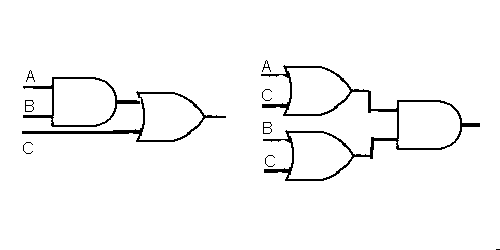Summer A 1998, Assignment 1
Due Tuesday 5/12 at the start of class
-
Are these two circuits equivalent? Draw the truth tables for each to prove
your answer.

-
Consider the three input boolean function that is 1 if the binary equivalent
of the inputs is a prime number (2, 3, 5, 7). Draw a circuit diagram for
this function:
-
Using SSI chips listed on page 89 of the book.
-
Using the MSI multiplexer chip.
-
Consider the three input boolean function that is a 1 if exactly one of the
inputs is 1.
-
Using SSI chips listed on page 89 of the book.
-
Using the MSI multiplexer chip.
-
Redo questions 2 and 3, but implement both circuits on the same LSI PLA.
Label the inputs for each differently (eg: A, B, C and D, E, F).Only draw
the gates and lines that you use. Draw all the lines into each gate (12 for
each AND gate). Indicate which fuses have been blown, and which have not.
-
A 2-bit demultiplexer is a circuit whose single input line is steered to
one of the four output lines depending on the state of the two control lines.
-
Draw the truth table for a 2-bit demultiplexer. There will be one input variable,
two control variables, and 4 output variables.
-
Draw the circuit for a 2-bit demultiplexer.
-
Draw the circuit for a 3-bit demultiplexer. There will be one input line,
three control lines, and 8 output lines.
-
A 2-bit encoder is a circuit with four input lines, exactly one of which
is high at any instant, and two output lines whose 2-bit binary value tells
which input is high.
-
Draw the truth table for a 2-bit encoder. There will be four input variables
and two output variables. Only one of the input varaibles can be 1 at a given
time, so there are only 4 possible states for the input variables.
-
Draw the circuit for a 2-bit encoder.
-
Draw the circuit for a 3-bit encoder. There will be 8 input lines and 3 output
lines.
-
Draw the truth table and try to summarize succinctly what this circuit does.
Hint: it is equivalent to a circuit we covered in class.

-
(Page 158, #16) A 16-bit ALU is built up of 16 1-bit ALUs, each one having
an add time of 100 nsec. If there is an additional 10 nsec delay for propagation
from one ALU to the next, how long does it take for the result of a 16-bit
add to appear?

